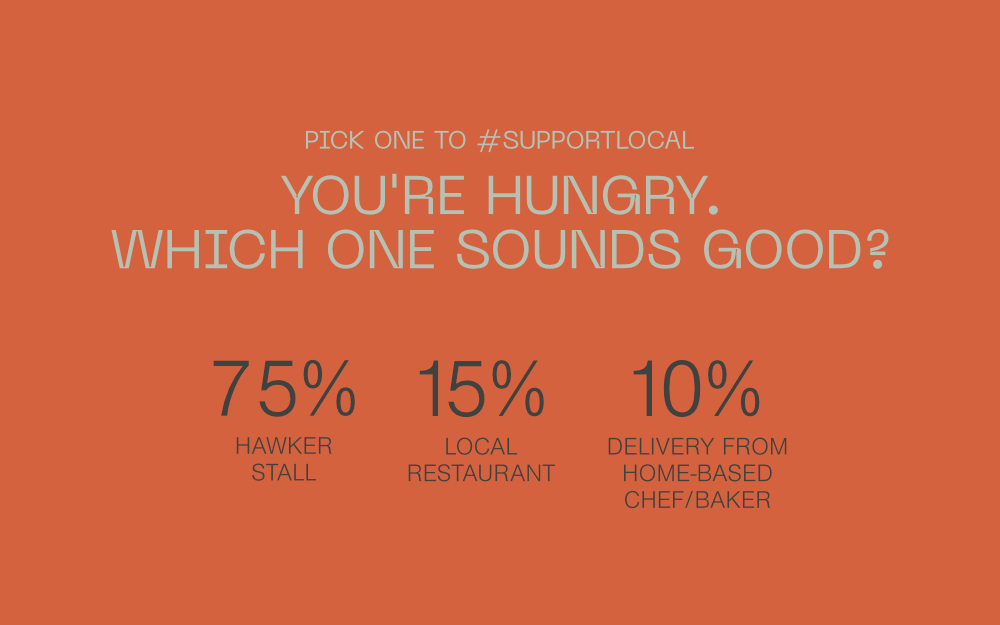In a COVID-19 economy, people really want to support local businesses. But is it an effective digital marketing tactic for boosting sales?
DOES #SupportLocal REALLY WORK?

©Somewhere Else
Many local businesses took a hit from the pandemic and subsequent lockdown, border closures, and social distancing rules. Stuck on this island, alone together, we found ways to show support to our communities.
We sent care packages to friends, introducing them to our neighbourhood curry puffs. We ordered sweet treats from home kitchens, and delivery from the impromptu WhatsApp and Facebook hawker groups. Chain gifting became a thing.
So of course, someone gave it a hashtag. Enter #SupportLocal.
As a shorthand for indicating that a business is locally owned and operated, it works. For customers actively looking for local businesses to support, #SupportLocal effectively says, “Over here! That’s us!” For everyone else, it is an appeal — much like “Save the Earth” or “Give Way to the Elderly.” If you aren’t already in compliance, the phrase either gently nags you to make a better choice, or shadily implies that you have an unfulfilled obligation.
We wondered, how much does #SupportLocal actually influence behaviour?
Does its effect (if any) apply equally across categories and tiers of goods & services?
In a spontaneous and completely unscientific poll via our Instagram Stories, here’s what we found.
![]()
So of course, someone gave it a hashtag. Enter #SupportLocal.
As a shorthand for indicating that a business is locally owned and operated, it works. For customers actively looking for local businesses to support, #SupportLocal effectively says, “Over here! That’s us!” For everyone else, it is an appeal — much like “Save the Earth” or “Give Way to the Elderly.” If you aren’t already in compliance, the phrase either gently nags you to make a better choice, or shadily implies that you have an unfulfilled obligation.
We wondered, how much does #SupportLocal actually influence behaviour?
Does its effect (if any) apply equally across categories and tiers of goods & services?
In a spontaneous and completely unscientific poll via our Instagram Stories, here’s what we found.

Purchase Frequency + Variety Available?
More people chose to use their Food & Groceries budget to #SupportLocal. Food & Groceries tend to be purchased more frequently; it’s a daily expenditure. Throughout Circuit Breaker, a range of food and grocery options remained accessible to us, spanning different price ranges, tastes, and availability. When the #SupportLocal movement was gaining momentum, Food & Groceries was the most natural beneficiary. On the other hand, clothes and accessories are infrequent purchases. Coupled with the closure of many retail outlets through circuit breaker, and the somewhat impersonal nature of online retail, we weren’t surprised to find that Clothes&Accessories commands less clout in the #SupportLocal conversation.
![]()
![]()
More people chose to use their Food & Groceries budget to #SupportLocal. Food & Groceries tend to be purchased more frequently; it’s a daily expenditure. Throughout Circuit Breaker, a range of food and grocery options remained accessible to us, spanning different price ranges, tastes, and availability. When the #SupportLocal movement was gaining momentum, Food & Groceries was the most natural beneficiary. On the other hand, clothes and accessories are infrequent purchases. Coupled with the closure of many retail outlets through circuit breaker, and the somewhat impersonal nature of online retail, we weren’t surprised to find that Clothes&Accessories commands less clout in the #SupportLocal conversation.

Least amount of change to existing behaviour?
We wanted to know more. Does #SupportLocal lend itself more naturally to some food options than others? Given the heavy media coverage of Instagram bakers and home kitchens throughout Circuit Breaker, we were surprised that they lost the #SupportLocal click test by such a heavy margin, coming in dead last at a depressing 10%. Winner by a landslide — the ubiquitous Hawker stall — the option that requires the least change in existing customer behaviour. The one that’s usually the cheapest and most easily available. The one with the most direct relationship between product, buyer, and seller. Ironically, hawker stalls are also least likely to be on your IG feed, pricking your conscience with #SupportLocal.
We wanted to know more. Does #SupportLocal lend itself more naturally to some food options than others? Given the heavy media coverage of Instagram bakers and home kitchens throughout Circuit Breaker, we were surprised that they lost the #SupportLocal click test by such a heavy margin, coming in dead last at a depressing 10%. Winner by a landslide — the ubiquitous Hawker stall — the option that requires the least change in existing customer behaviour. The one that’s usually the cheapest and most easily available. The one with the most direct relationship between product, buyer, and seller. Ironically, hawker stalls are also least likely to be on your IG feed, pricking your conscience with #SupportLocal.

We’ve been Supporting Local all along?!
How about grocery options? Again, the winners (Wet market and Neighbourhood minimart) are part of the established rhythms of local life (for most of us anyway), even before the pandemic. Does this mean we’ve been “supporting local” all along, even without a hashtag to remind us? An ethical appeal to support a community in crisis, finds us in no need of any behavioural adjustment—then why bother with the hashtag at all?
Or does it mean that our perception of “local” is firmly tied to the individuals who run hawker stalls, wet market stalls, and minimart counters? Our interactions at these local spots are certainly more personal than clicking “Buy Now”, even if it’s a local online retailer. Our stall of choice depends so much on where we live, where we work, and whose recommendation we take--an extremely local and unique experience. If this association of “local” to “known individual” holds true, what does that mean for local online retailers hoping to activate #SupportLocal in their favour?
What does this mean for local businesses?
Perhaps it just means that while we all want to #SupportLocal, we have limited time, money, and energy to venture too far outside our comfort zones, especially in categories so ruled by habit and personal preference. It’s definitely a given that no hashtag will change behaviour overnight.
How about grocery options? Again, the winners (Wet market and Neighbourhood minimart) are part of the established rhythms of local life (for most of us anyway), even before the pandemic. Does this mean we’ve been “supporting local” all along, even without a hashtag to remind us? An ethical appeal to support a community in crisis, finds us in no need of any behavioural adjustment—then why bother with the hashtag at all?
Or does it mean that our perception of “local” is firmly tied to the individuals who run hawker stalls, wet market stalls, and minimart counters? Our interactions at these local spots are certainly more personal than clicking “Buy Now”, even if it’s a local online retailer. Our stall of choice depends so much on where we live, where we work, and whose recommendation we take--an extremely local and unique experience. If this association of “local” to “known individual” holds true, what does that mean for local online retailers hoping to activate #SupportLocal in their favour?
What does this mean for local businesses?
Perhaps it just means that while we all want to #SupportLocal, we have limited time, money, and energy to venture too far outside our comfort zones, especially in categories so ruled by habit and personal preference. It’s definitely a given that no hashtag will change behaviour overnight.
For companies looking to boost their appeal with #SupportLocal, here’s what we recommend:
“Local” isn’t a personality. What else makes your product special? Why should people notice your brand?
2)
Don’t count on riding the trend
3)
As evidenced by our entirely unscientific poll, people tend to have a specific group in mind when they do choose to #SupportLocal. Are you a legacy hawker stall with an army of regulars who live and breathe your char kway teow? Would your absence leave an unfillable void in your customers’ lives? If not, it’s going to be an uphill battle to convert that supportive sentiment into dollars.
Before jumping on the bandwagon, assess how your customers actually feel about your business. If you know who you are, and who your customers are, you’ll know if #SupportLocal will work for you.
Don’t misinterpret broad sentiment for specific action
Before jumping on the bandwagon, assess how your customers actually feel about your business. If you know who you are, and who your customers are, you’ll know if #SupportLocal will work for you.




